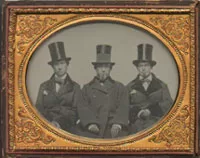FEATURE Series: Collecting Old, Antique and Vintage Photography
Albumen print
Prints made on a paper coated with an egg white and salt solution, then sensitized with silver nitrates.
Candid Shot
The refinement of smaller cameras and better lens in the 1920s made practical the “candid shot” – a non-posed, photograph taken indoors with available light. Unburdened by large apparatus and distracting flashes, photographers could capture relaxed moments for the first time.
Cliché verre
From the French for “glass negative,” denotes a particular use of glass as a negative for a drawing. Used as early as 1835, this photographic method allows the artist to add painterly touches to the photographic negative.
Daguerreotype
An early photographic process invented by the Frenchman Louis Jacques Mande Daguerre in the 1830s. Images were imprinted on sheets of copper that had been coated with silver on one side, then polished to a mirror-bright sheen. Thousands of daguerreotypes were produced but the lack of reproducibility doomed it to obsolescence once glass negatives were introduced in the 1850s.
Group f.64
Loosely affiliated group of mostly West Coast photographers who advocated the “straight” style of photography. Inpsired by the work of Edward Weston, charter members included Ansel Adams and Imogene Cunningham. These non-pictorialists named their group for the aperture position that secures the maximum image sharpness in both the foreground and distance.
Gelatin print
The “driest of the dry processes.” Developed in the 1870s, gelatin dry plates solved many of the technical problems associated with developing photographs and led to the standardization of materials.
Platinum print
Also known as a contact print. Because its taken directly from the negative, it has the highest level of detail possible.
Photogravure
An intaglio printing process for reproducing photographic images in printers ink.
Photomontage
The pasting together or otherwise assembling of separate or disparate elements to form a new visual whole. Photomontage’s origins lay in the Dadaist movement and, by mixing photography, illustration and other elements, helped bridge the gap between photography and other art forms.
Pictorialists
Early 20th century movement that sought to promote photography as an expressive medium. Typical pictorialist works are characterized by soft-focus, low tonality and careful composition.
Photo Secession
American movement spearheaded by Alfred Stieglitz at the turn of the 20th century. Works of the Photo-Secessionists were showcased in seminal photography journal, Camera Work, and in exhibitions at Stieglitz’s Little Galleries at 291 Fifth Avenue in New York. Helped establish the credibility of photography as an art form.
Silver print
A generic term referring to all prints made on paper coated with silver salts. Most contemporary black and white photographs are silver prints.
Solarization
A reversal of tones in a photograph due to gross overexposure. Solarization causes a negative to revert to a positive.
Vintage print
A photograph printed within approximately five years of the date when the negative was made. Later prints are called modern prints.







